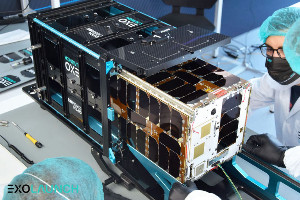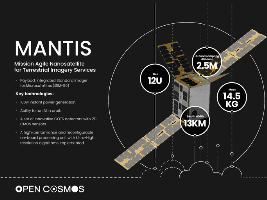| Spacecraft | MANTIS (Mission and Agile Nanosatellite for Terrestrial Imagery Services, OpenConstellation?) |
|---|---|
| Form factor | CubeSat |
| Units or mass | 12U |
| Status | Operational (LinkedIn post after launch as of 2023-12-12) |
| Launched | 2023-11-11 |
| NORAD ID | 58257 |
| Deployer | EXOpod Nova 12U/16U [Exolaunch] |
| Launcher | Falcon 9 (Transporter-9) |
| Organization | Open Cosmos |
| Institution | Company |
| Entity type | Commercial |
| Headquarters | UK |
| Manufacturer | AIVT by Open Cosmos |
| Operator | Open Cosmos |
| Launch brokerer | SAB Launch Services |
| Partners | Satlantis, Terrabotics, ESA (European Space Agency), UK Space Agency |
| Oneliner |
Earth observation satellite with novel data analysis. Possibly a start of a constellation. |
| Description |
First of an aggregated constellation operated by Open Cosmos where customers will have access to diverse types and volumes of information depending on the number of satellites contributed to the constellation. Periodic statistics reports on activity in the regions of interest, computed through the latest data processing and machine learning techniques on top of other data sets, such as Copernicus. The satellite will obtain images to feed these data processing algorithms in a revisit pattern that is optimised for specific areas of interest. The high resolution of these images will be complementary to lower resolution data that is already available from the Copernicus programme. The requirements of the natural resources sector for remote sensing products are generally very demanding both in terms of data quality and coverage/revisit time. The space segment is composed by the Open Cosmos 12U spacecraft platform hosting the Satlantis Microsats SL iSIM-12U (integrated Standard Imager for Microsatellites), an innovative high-resolution optical payload for Earth Observation missions. iSIM-12U is a compact binocular telescope specifically designed to fit within a volume of 8U, and thus ideal for 12U CubeSat standard platforms. The design relies on the integration of four key technologies: a binocular diffraction-limited optical system working at visible and near-infrared wavelength; a high precision, robust and light structure; a set of innovative COTS detectors with 2D CMOS sensors; a high-performance and reconfigurable processing unit with Super-resolution algorithms implemented on-board. The downstream heart is represented by Terrabotics’ object recognition and change detection algorithms which will enable the processing of data on ground using the latest machine learning techniques. |
| Results |
Downloading clear, strong images just eleven days post launch. |
| Sources | [1] [2] [3] [4] [5] [6] |
| Photo sources | [1] [2] [3] [4] [5] [6] |
| COTS subsystems |
|
| Space photos |   
|
| On the same launch |
|
Last modified: 2024-05-26








